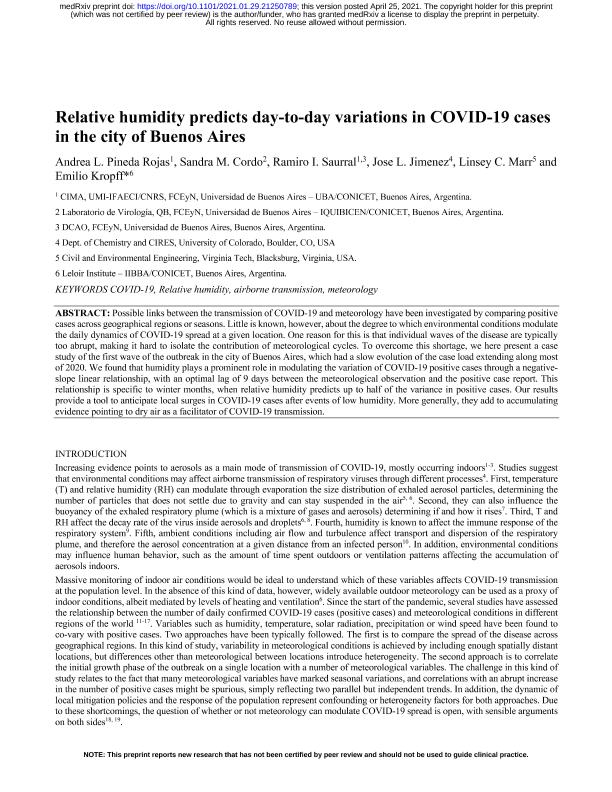Artículo
Relative humidity predicts day-to-day variations in COVID-19 cases in the city of Buenos Aires
Pineda Rojas, Andrea Laura ; Cordo, Sandra Myriam
; Cordo, Sandra Myriam ; Saurral, Ramiro Ignacio
; Saurral, Ramiro Ignacio ; Jimenez, Jose L.; Marr, Linsey C.; Kropff, Emilio
; Jimenez, Jose L.; Marr, Linsey C.; Kropff, Emilio
 ; Cordo, Sandra Myriam
; Cordo, Sandra Myriam ; Saurral, Ramiro Ignacio
; Saurral, Ramiro Ignacio ; Jimenez, Jose L.; Marr, Linsey C.; Kropff, Emilio
; Jimenez, Jose L.; Marr, Linsey C.; Kropff, Emilio
Fecha de publicación:
30/07/2021
Editorial:
American Chemical Society
Revista:
Environmental Science & Technology
ISSN:
0013-936X
Idioma:
Inglés
Tipo de recurso:
Artículo publicado
Clasificación temática:
Resumen
Possible links between the transmission of COVID-19 and meteorology have been investigated by comparing positive cases across geographical regions or seasons. Little is known, however, about the degree to which environmental conditions modulate the daily dynamics of COVID-19 spread at a given location. One reason for this is that individual waves of the disease typically rise and decay too sharply, making it hard to isolate the contribution of meteorological cycles. To overcome this shortage, we here present a case study of the first wave of the outbreak in the city of Buenos Aires, which had a slow evolution of the caseload extending along most of 2020. We found that humidity plays a prominent role in modulating the variation of COVID-19 positive cases through a negative-slope linear relationship, with an optimal lag of 9 days between the meteorological observation and the positive case report. This relationship is specific to winter months, when relative humidity predicts up to half of the variance in positive case count. Our results provide a tool to anticipate possible local surges in COVID-19 cases after events of low humidity. More generally, they add to accumulating evidence pointing to dry air as a facilitator of COVID-19 transmission.
Palabras clave:
METEOROLOGY
,
RELATIVE HUMIDITY
,
AIRBORN TRANSMISSION
,
COVID-19
Archivos asociados
Licencia
Identificadores
Colecciones
Articulos(IIBBA)
Articulos de INST.DE INVEST.BIOQUIMICAS DE BS.AS(I)
Articulos de INST.DE INVEST.BIOQUIMICAS DE BS.AS(I)
Citación
Pineda Rojas, Andrea Laura; Cordo, Sandra Myriam; Saurral, Ramiro Ignacio; Jimenez, Jose L.; Marr, Linsey C.; et al.; Relative humidity predicts day-to-day variations in COVID-19 cases in the city of Buenos Aires; American Chemical Society; Environmental Science & Technology; 55; 16; 30-7-2021; 11176–11182
Compartir
Altmétricas



